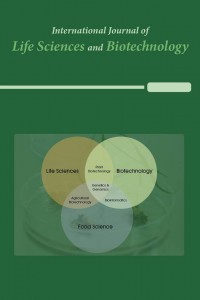Antitumor Activity of Etoposide, Puerarin, Galangin and Their Combinations in Neuroblastoma Cells
Antitumor Activity of Etoposide, Puerarin, Galangin and Their Combinations in Neuroblastoma Cells
___
- 1. Urbani, A., et al., A proteomic investigation into etoposide chemo‐resistance of neuroblastoma cell lines. Proteomics, 2005. 5(3): p. 796-804.
- 2. Steliarova-Foucher, E., et al., International incidence of childhood cancer, 2001-10: a population-based registry study. Lancet Oncol, 2017. 18(6): p. 719-731.
- 3. Maris, J.M., et al., Neuroblastoma. Lancet, 2007. 369(9579): p. 2106-20.
- 4. Pinto, N.R., et al., Advances in Risk Classification and Treatment Strategies for Neuroblastoma. J Clin Oncol, 2015. 33(27): p. 3008-17.
- 5. Berger, S.J., et al., Green tea constituent (--)-epigallocatechin-3-gallate inhibits topoisomerase I activity in human colon carcinoma cells. Biochem Biophys Res Commun., 2001. 288(1): p. 101-5.
- 6. Nitiss, J.L., Targeting DNA topoisomerase II in cancer chemotherapy. Nat Rev Cancer, 2009. 9(5): p. 338-50.
- 7. Karpinich, N.O., et al., The course of etoposide-induced apoptosis from damage to DNA and p53 activation to mitochondrial release of cytochrome c. J Biol Chem, 2002. 277(19): p. 16547-52.
- 8. Janicke, R.U., D. Sohn, and K. Schulze-Osthoff, The dark side of a tumor suppressor: anti-apoptotic p53. Cell Death Differ, 2008. 15(6): p. 959-76.
- 9. Yonish-Rouach, E., The p53 tumour suppressor gene: a mediator of a G1 growth arrest and of apoptosis. Experientia, 1996. 52(10-11): p. 1001-7.
- 10. Heo, M.Y., S.J. Sohn, and W.W. Au, Anti-genotoxicity of galangin as a cancer chemopreventive agent candidate. Mutat Res., 2001. 488(2): p. 135-150.
- 11. Bacanli, M., A.A. Basaran, and N. Basaran, The antioxidant, cytotoxic, and antigenotoxic effects of galangin, puerarin, and ursolic acid in mammalian cells. Drug Chem Toxicol, 2017. 40(3): p. 256-262.
- 12. Zhang, H.T., et al., Galangin induces apoptosis of hepatocellular carcinoma cells via the mitochondrial pathway. World J Gastroenterol, 2010. 16(27): p. 3377-84.
- 13. Zeng, H., et al., Galangin-induced down-regulation of BACE1 by epigenetic mechanisms in SH-SY5Y cells. Neuroscience, 2015. 294: p. 172-81.
- 14. Zhang, W., et al., Galangin induces B16F10 melanoma cell apoptosis via mitochondrial pathway and sustained activation of p38 MAPK. Cytotechnology, 2013. 65(3): p. 447-55.
- 15. Zou, W.-W. and S.-P. Xu, Galangin inhibits the cell progression and induces cell apoptosis through activating PTEN and Caspase-3 pathways in retinoblastoma. Biomed Pharmacother., 2018. 97: p. 851-863.
- 16. Li, J., et al., Anti-colorectal cancer biotargets and biological mechanisms of puerarin: Study of molecular networks. Eur J Pharmacol, 2019. 858: p. 172483.
- 17. Zhou, Y.X., H. Zhang, and C. Peng, Puerarin: a review of pharmacological effects. Phytother Res, 2014. 28(7): p. 961-75. 18. Berney, D.M., et al., DNA topoisomerase I and II expression in drug resistant germ cell tumours. British Journal of Cancer, 2002. 87(6): p. 624-629.
- 19. Wen, M., et al., Galangin Induces Autophagy through Upregulation of p53 in HepG2 Cells. Pharmacology, 2012. 89(5-6): p. 247-255.
- 20. Liu, D., et al., Galangin Induces Apoptosis in MCF-7 Human Breast Cancer Cells Through Mitochondrial Pathway and Phosphatidylinositol 3-Kinase/Akt Inhibition. Pharmacology, 2018. 102(1-2): p. 58-66.
- 21. Wang, N., et al., Puerarin protected the brain from cerebral ischemia injury via astrocyte apoptosis inhibition. Neuropharmacology, 2014. 79: p. 282-289.
- 22. Hu, Y.F., et al., Puerarin inhibits non-small cell lung cancer cell growth via the induction of apoptosis. Oncology Reports, 2018. 39(4): p. 1731-1738.
- 23. Yu, Z.L. and W.J. Li, Induction of apoptosis by puerarin in colon cancer HT-29 cells. Cancer Letters, 2006. 238(1): p. 53-60.
- 24. Ye, G.M., et al., Puerarin in inducing apoptosis of bladder cancer cells through inhibiting SIRT1/p53 pathway. Oncology Letters, 2019. 17(1): p. 195-200.
- Yayın Aralığı: Yılda 3 Sayı
- Başlangıç: 2018
- Yayıncı: International Society of Academicians
Leyla GÜVEN, Ufuk ÖZGEN, Handan SEVİNDİK, İclal AĞAN, Mehmet KOCA, İbrahim TURAN, Selim DEMİR, Yüksel ALİYAZICIOĞLU
SARS-CoV-2 Spike Protein Reseptör Bağlanma Bölgesinde L18F Mutasyonunun Homoloji Modellemesi
Gizem KÖPRÜLÜLÜ KÜÇÜK, Nazlı Irmak GİRİTLİOĞLU
Daniel KİMSANALİEV, Sevgi MARAKLI, Yilmaz KAYA
YENİLİKÇİ KENDİNDEN İYİLEŞEN HİDROJEL KOMPOZİT OLARAK AZOT KATKILI KARBON KUANTUM DOTS-GELLAN GUM
Elifcan ÇALIŞKAN, Berat Zeki HAZNEDAROĞLU
Mustafa TOPU, İskender TİRYAKİ
Yasemin NUMANOĞLU ÇEVİK, Mehmet Ali KANAT
Karbon noktaların tarımsal üretimde kullanılması
Mehmet Han BAŞTÜRK, Şahane Funda ARSLANOĞLU, Rumeysa ÖZTÜRK
Abdullahi AJAO, Ganiyat ALASİNRİN
A Current and Common Cause of Secondary Spontaneous Pneumothorax: Covid- 19 Pneumonia
Nurmuhammet TAŞ, Muhammet NALDAN, Fatih ÖNER, Hülya NALDAN, Yener AYDİN
